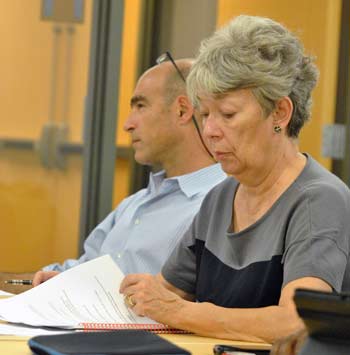Art Commission, In Transition, Takes Hiatus
Ann Arbor public art commission meeting (June 18, 2014): In what might be their last formal meeting for the foreseeable future, the city’s public art commissioners discussed their role in the context of ongoing transitions for the public art program.
One aspect of that transition is the departure of the part-time public art administrator, Aaron Seagraves. His current contract ends on June 30 – the final day of the current fiscal year. Seagraves has been working as the public art administrator on a contract basis since May of 2011.
In addition, one of the art commissioners – Ashlee Arder, who was appointed in March of 2013 – has resigned because of a move to Detroit. She did not attend the June 18 meeting.
Six of the nine commissioners who were present at the meeting approved a resolution about AAPAC’s near-term future. It states that the commission “will not initiate any new public arts projects, nor take any action to seek public or private funds for new projects, until it receives: direction on implementing a transition, a plan to support the Public Art Commission in the furtherance of public art, and guidelines for the funding and management of public art projects…” The resolution also states that AAPAC won’t meet until feedback is needed on the transition plan or for ongoing projects.
AAPAC chair Bob Miller, who introduced the resolution, described it as a way “to tie things up in a neat package for us, until the city has a clear direction for us to move forward.”
In other action, the commission authorized using $10,981 for a project called “PowerArt,” to be administered by the nonprofit Arts Alliance in response to a request by the Ann Arbor Downtown Development Authority. The DDA is contributing $20,000 to the first phase of the project, which involves wrapping eight traffic signal boxes in the DDA district with vinyl printed replicas of artwork. The expenditure from the city is not from Percent for Art funds, but rather from money donated to the city for public art, and held by the Ann Arbor Area Community Foundation.
Discussion among commissioners focused on the fact that the Arts Alliance is proposing a roughly 40% project management fee for the first cycle – $9,100 on top of the $23,000 budget for the project expenses. The fee, as a percentage of the project’s later cycles, is expected to decrease in subsequent cycles. If the entire project is completed, an additional 34 boxes would be wrapped.
Commissioners also were updated on several ongoing projects that have been previously undertaken by AAPAC: (1) the Coleman Jewett memorial; (2) sculptures at a rain garden at Kingsley & First; (3) artwork for East Stadium bridges; and (4) Canoe Imagine Art.
Another effort that’s being developed by commissioner KT Tomey – maps for walking, cycling or running self-guided tours of public art – is also moving ahead, though it’s not an official city project. Commissioners intend to continue work on these projects to some degree, despite their decision to hold off on meetings and new initiatives. [Full Story]







